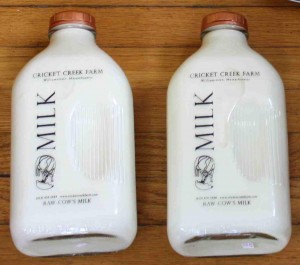 A couple weeks back, the crew here had the opportunity to sit down with cheesemaker and monger Paul Lawler, now a CFF apprentice alumni, before he departed for Cranberry Creek Farm in the Poconos to make what will prove to be some stellar goat’s milk cheese. Paul presented us first with a well-prepared lesson on proper tasting, which was equally well-appreciated, especially on my behalf, since the steepest learning curve I’ve brought with me to Cricket Creek is probably that of developing the proficient and polished palate fitting of a cheesemaker. And after guiding the group through the fundamentals of tasting with our eyes, hands, noses, and yes, ultimately our mouths, Paul presented us with a carefully composed tasting plate and the opportunity to put our newly-learned lessons to use.
A couple weeks back, the crew here had the opportunity to sit down with cheesemaker and monger Paul Lawler, now a CFF apprentice alumni, before he departed for Cranberry Creek Farm in the Poconos to make what will prove to be some stellar goat’s milk cheese. Paul presented us first with a well-prepared lesson on proper tasting, which was equally well-appreciated, especially on my behalf, since the steepest learning curve I’ve brought with me to Cricket Creek is probably that of developing the proficient and polished palate fitting of a cheesemaker. And after guiding the group through the fundamentals of tasting with our eyes, hands, noses, and yes, ultimately our mouths, Paul presented us with a carefully composed tasting plate and the opportunity to put our newly-learned lessons to use.
For starters, Paul set out two milks and informed us that we would taste a pasteurized whole milk from a well-known local, “conventional” dairy as well as our own, raw whole milk. He didn’t tell us which was which and I was nervous that my dumb tongue (and nose) would embarrass me. I was even more anxious after tasting the first milk, because I didn’t like it. There wasn’t much to say about it, at least not much that was positive. I was worried that, when actually asked to consider milk, I wouldn’t discern much. I was scared that I wouldn’t be able to tell the difference between the milks, that I might misidentify them, that, at best, I would have to confess to not liking milk as much as I had previously professed, and at worst, that I might like another milk, a pasteurized milk, and have to admit this to my farming and cheesemaking coworkers.
I timidly picked up and sipped the second milk. I was astonished. I thought that I might have trouble distinguishing the two, but I almost didn’t believe the incredible difference that I tasted. The second was substantial and had a sweetness to it. It felt filling, but also left me wanting more. It was nothing like the white water I had gulped down prior. Without a doubt, I had biases about milk, but this was a blind taste test and the afternoon’s lessons had left me with a beginner’s mind: open, eager, and without preconceptions. In fact, I think that allowed me to be bowled over (“Wow, this is SO good”) rather than blasé (of course it’s good, I could have told you that”). More than any other point during the afternoon’s lesson, tasting exercises , and the tasting itself, I was confident articulating what I had tasted and announcing that the second milk was our milk, Cricket Creek Farm milk. It may have been the only time I was on point all afternoon.
The vast qualitative difference between our milk and the other milk made me wonder why anyone would drink anything akin to the pasteurized milk that started our tasting. Accessibility is certainly an issue-for a lot of folks, it’s not easy to get good milk. But then I remembered that many Americans aren’t drinking milk anymore, period. According to a December article in the Wall Street Journal, “Per Capita U.S. milk consumption…has fallen almost 30% since 1975” and 2012 saw the biggest year-over year decline in 37 years, with Americans drinking on average 3.3% less milk than in 2011. That means that Americans drank an average of 20.2 gallons of milk last year, an amount I think I have consumed in the month I’ve been on the farm and one that is less than half of the 44 gallons of soda per capita Americans drank last year. The Journal posits that such a decline is more pronounced in “an age of vitamin waters and energy drinks” and I suppose that’s true to a certain extent. Likewise, so too is Gawker’s quip (in the article that sent me to the WSJ) that Americans consider themselves “too good” to drink milk, even if Gawker assertion was made tongue-in-cheek.
If most Americans only have experience with and exposure to poor quality milk, if that’s all they know and that’s all that’s readily available, why would they drink it? If flavored, sweetened, and “energized” waters abound, why would folks choose a bland and watery milk (which is really milk robbed of all its enduring and endearing qualities)? Most folks are too good for the milk that is cooked at ultra-high temperatures to be trucked across the country and sold at gas stations, not because they are haughty, but because deep down, most folks know that it’s not that good and want something better. Good milk has substance, good milk is sweet (though not sickly so), and good milk is sustaining (in a way that no energy drink could ever be). I consider myself very fortunate to have good milk so close at hand and as much as I appreciate it now, I’m looking forward to drinking and discovering more as I develop my palate here at Cricket Creek.
